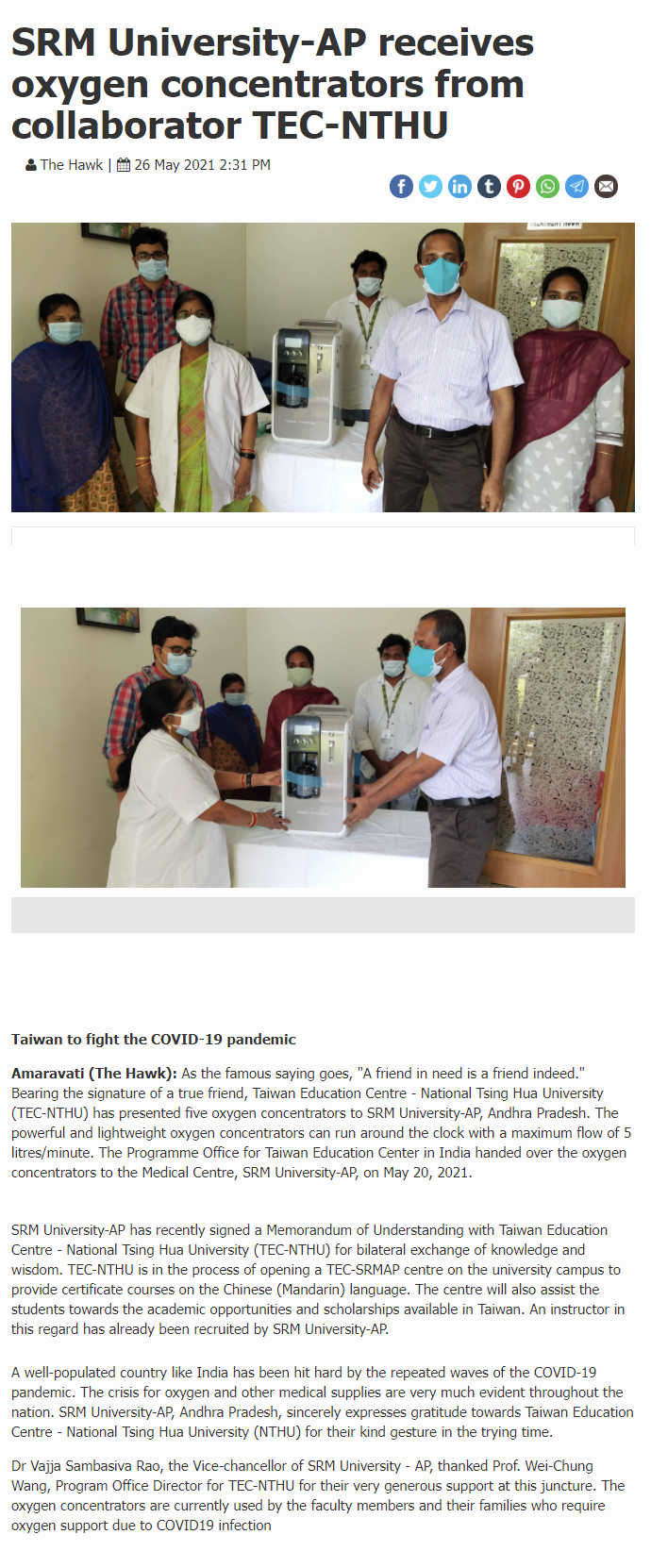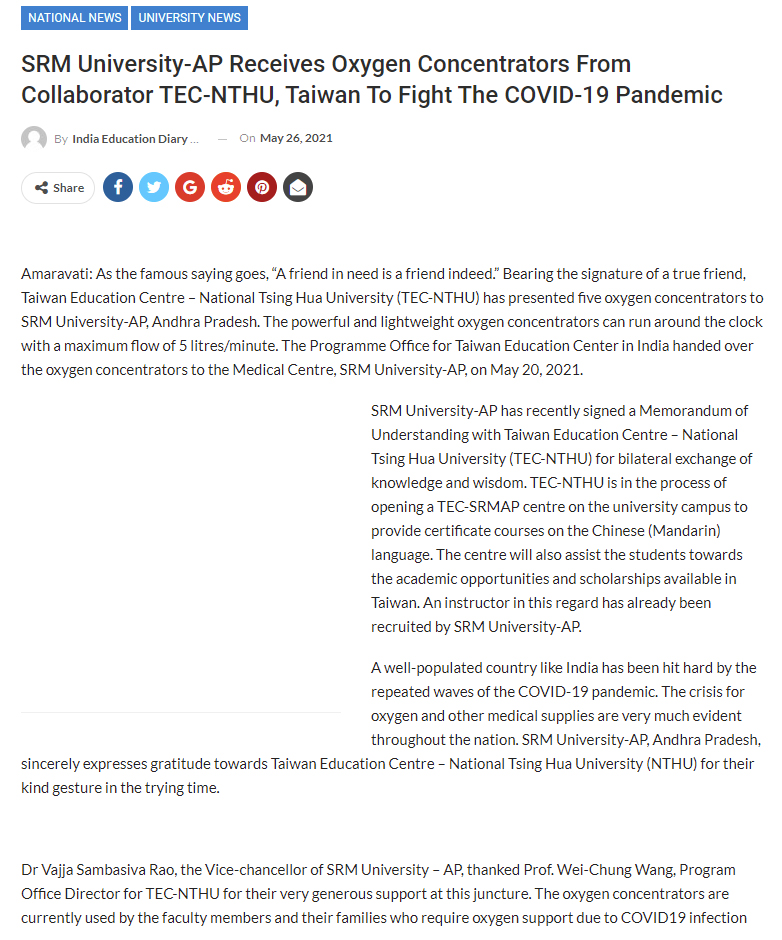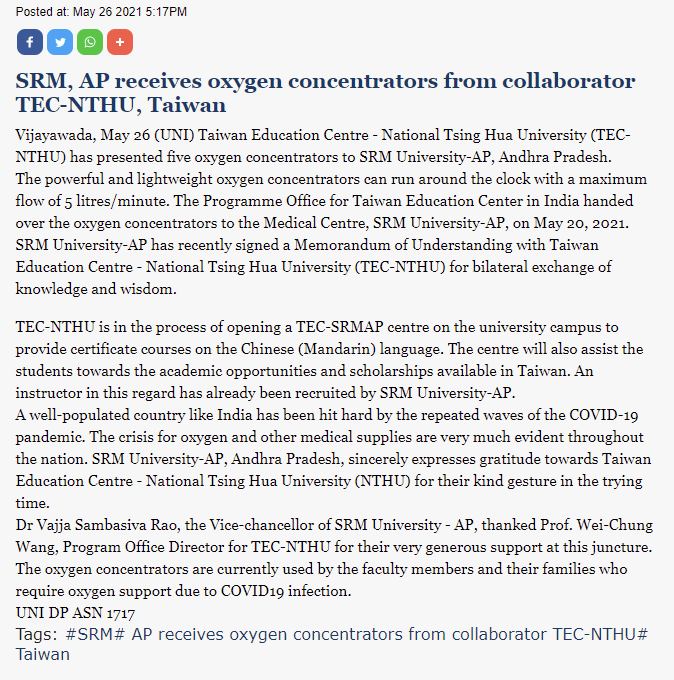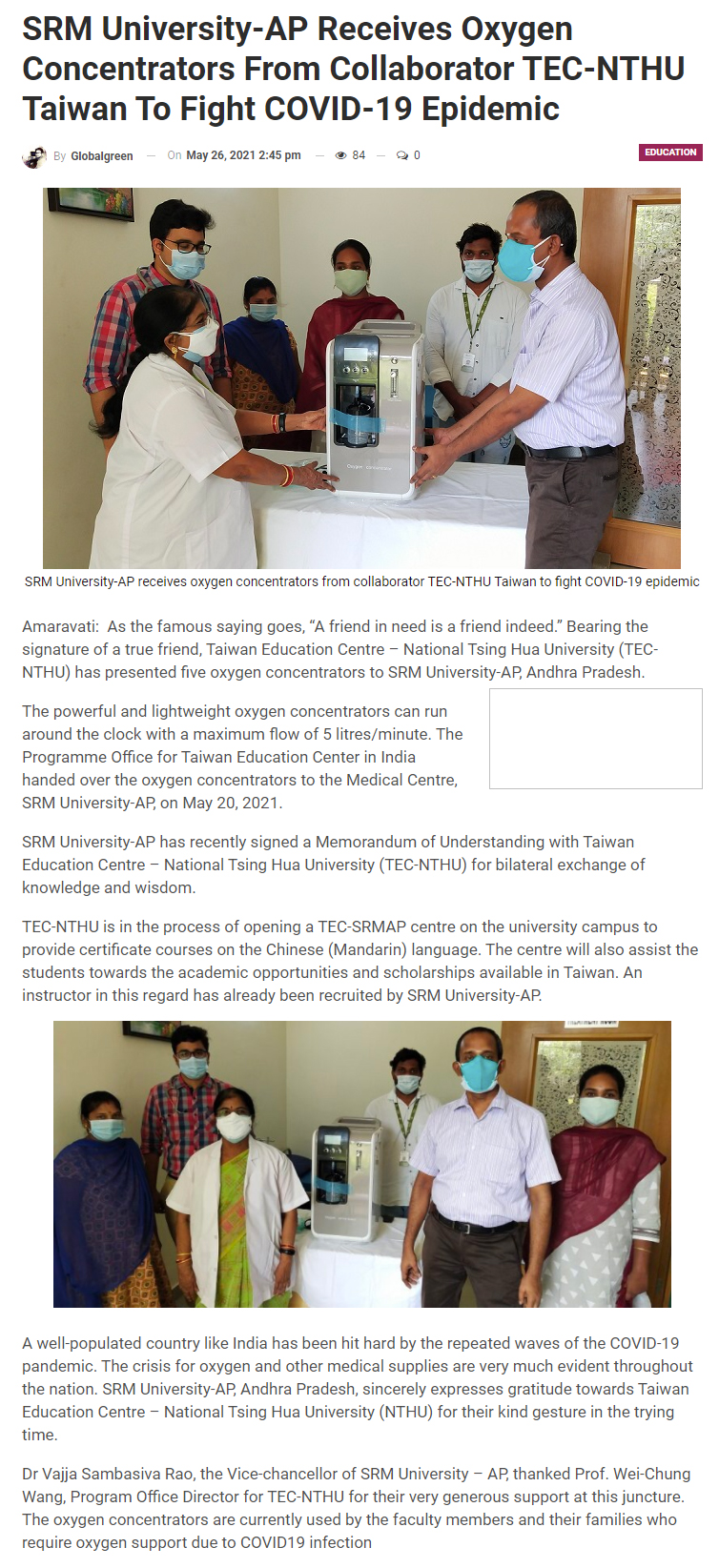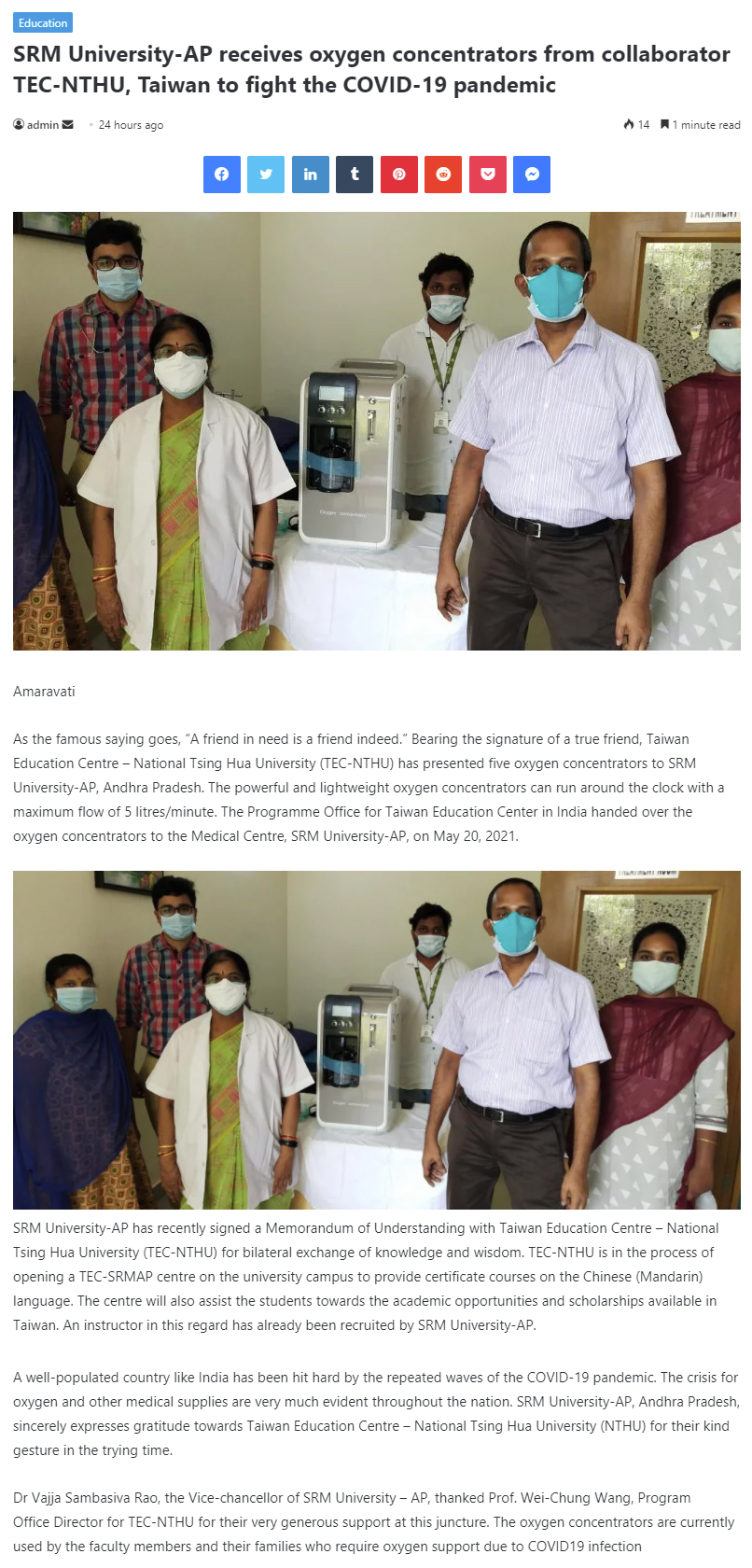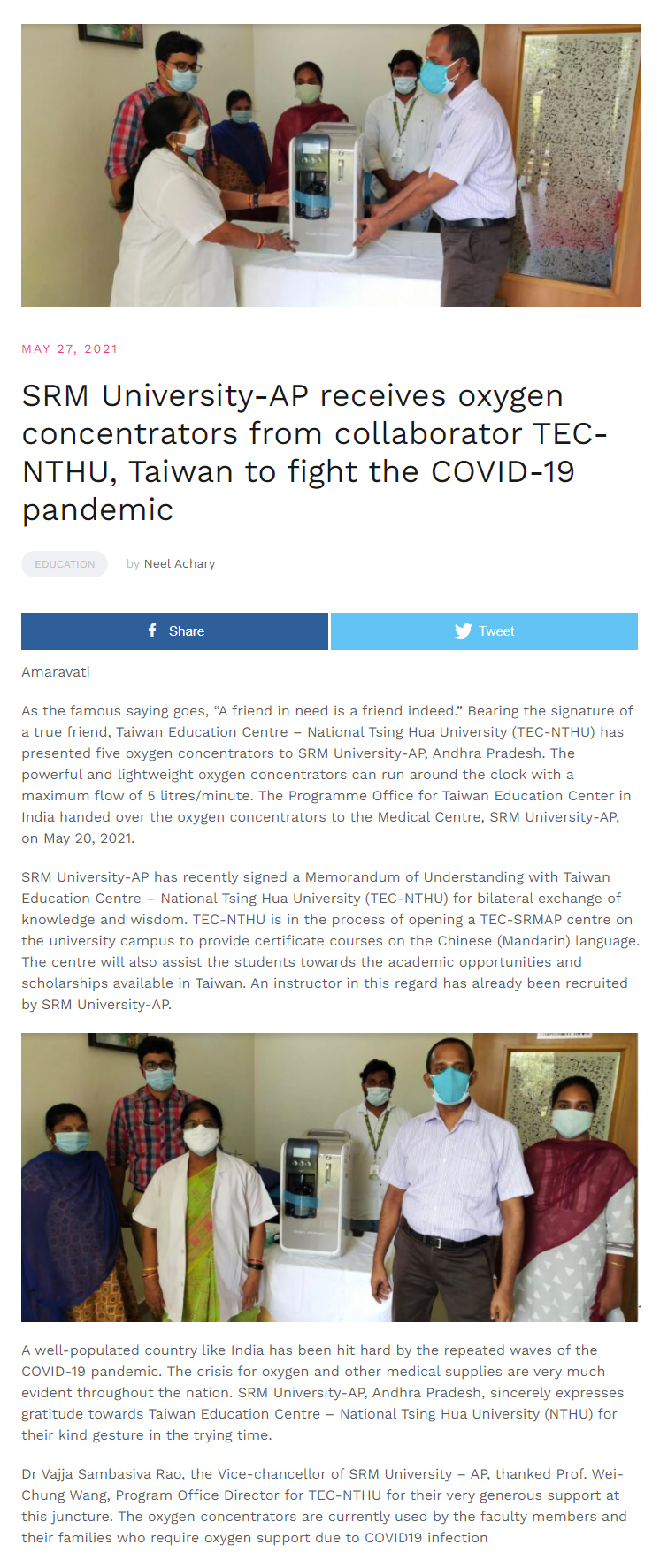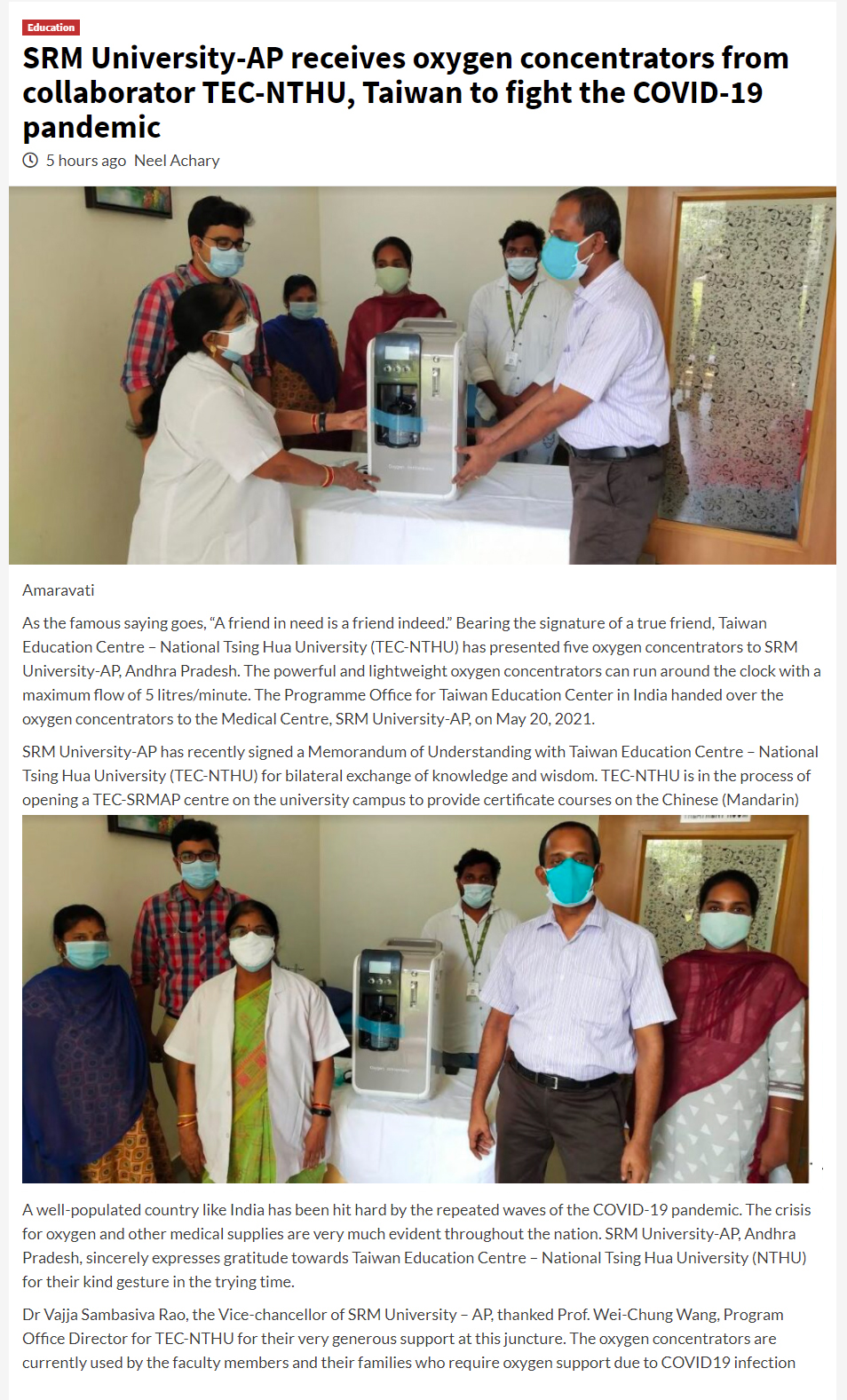All Management Events
- ECE Students admitted to prestigious universities across the globe May 30, 2021
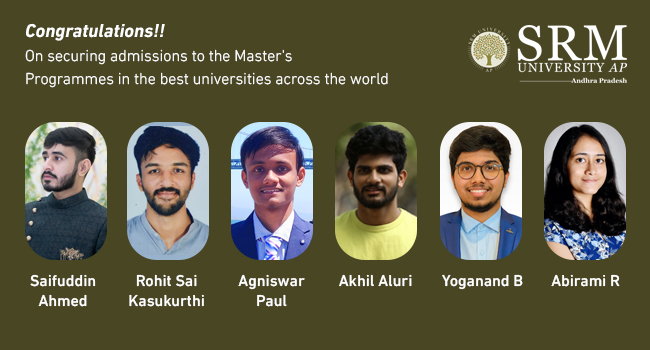 The Department of Electronics and Communication at SRM University-AP, Andhra Pradesh, is overjoyed to announce its students’ success in pursuing higher education. Six students from the maiden batch have performed brilliantly and been accepted to prestigious universities in the United States. These students are offered the opportunity to pursue a master’s degree in their chosen fields. Four of the six pupils have been accepted to New York University, and the remaining two are admitted to The University of Wisconsin-Madison and Georgia Institute of Technology in the United States of America.
The Department of Electronics and Communication at SRM University-AP, Andhra Pradesh, is overjoyed to announce its students’ success in pursuing higher education. Six students from the maiden batch have performed brilliantly and been accepted to prestigious universities in the United States. These students are offered the opportunity to pursue a master’s degree in their chosen fields. Four of the six pupils have been accepted to New York University, and the remaining two are admitted to The University of Wisconsin-Madison and Georgia Institute of Technology in the United States of America.Saifuddin Ahmed, Akhil Aluri, Rohit Sai K, and Abirami Ravishankar have been awarded a handsome annual scholarship from New York University. The host university offered a grant of $10,000, $8000, $8000, and $11000, respectively. Among the four students, Saifuddin, Akhil, Rohit and Abirami, the first three opted for a master’s in Management of Technology and Abirami enrolled in the Department of Electrical Engineering. Agnishwar Paul is selected by Georgia Tech University while B Yogananda took admission in the Master’s-Research Programme at The University of Wisconsin-Madison. Yogananda has received an offer for Teaching Assistantship from University of Wisconsin, Madison and as a part of it, he will also be receiving a Monthly Stipend and full Tuition Fee Wavier.
Students indicated that the in-depth knowledge that they gained during their B. Tech studies made them very confident while applying for higher studies. Agniswar said, “The curriculum that is followed in the university is up-to-date and at par with reputed global universities. It helped me a lot to catch up with the expectations of my preferred university.” Saifuddin added, “I was a bit doubtful at first whether to pursue higher studies after graduation. But the sincere guidance of Dr Sunil Chinnadurai and Higher Connect Club invoked the hunger in me to seek more knowledge.”
Higher Connect Club (HCC) is the university’s dedicated wing to connect all ECE students interested in pursuing Higher Education after they graduate from SRM University – AP. This club is focused on clarifying all the doubts that usually arise in a student’s mind when pursuing higher education and provides required support with all the resources required, guiding in the best possible way.
“My professors helped me to come up with the right strategy to score well in GRE. All of our teachers have international exposures. It helped a lot during our preparations for higher studies,” said Yogananda. Apart from strong grades in undergraduate courses, selection rounds of interviews needed proficiency in work experience and extracurricular activities. “The experience we gained during the Semester Abroad Programme and Capstone Projects added value to the resume, which helped us tremendously to prove our merit,” asserted Abirami.
The Department of ECE is pleased with students’ accomplishments and encourages future batches to emulate them, bringing honour to SRM University-AP, Andhra Pradesh. Prof Siva Sankar Yellampalli, Head of the Department, said, “We are proud of our students. The first batch is about to graduate. We feel saddened to bid them goodbye, but at the same time, it makes me extremely happy to know that they are going to pursue their chosen paths. My best wishes are always with them.”
Continue reading → - Grad students developed society friendly apps, won Hackathons May 30, 2021
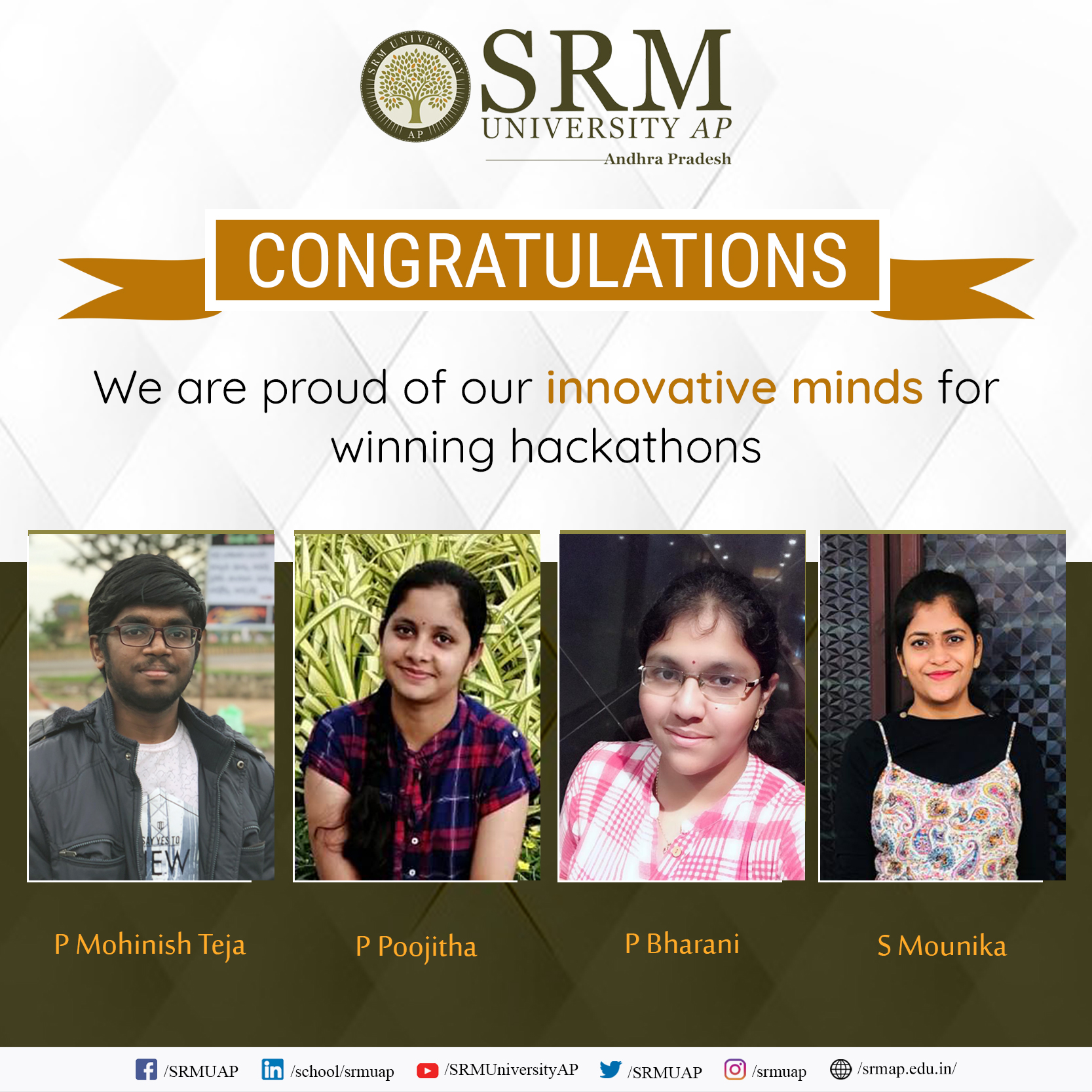 The SRM University-AP student, P Mohinish Teja from the Department of Computer Science and Engineering, brings laurel to the university by bagging the first prize at the Hackathon organised this year on April 16-18th by the Cal Hacks Team, University of California, Berkeley. More than 450 participants signed up for the world’s popular code-fest. Amongst these global participants, Mohinish won the title of “Best Hack” and a prize of $1000 worth of file coins from the sponsoring partner, Protocol Labs.
The SRM University-AP student, P Mohinish Teja from the Department of Computer Science and Engineering, brings laurel to the university by bagging the first prize at the Hackathon organised this year on April 16-18th by the Cal Hacks Team, University of California, Berkeley. More than 450 participants signed up for the world’s popular code-fest. Amongst these global participants, Mohinish won the title of “Best Hack” and a prize of $1000 worth of file coins from the sponsoring partner, Protocol Labs.The idea of the application “Eco gift” is inspired by the Undergraduate Research Oriented Project under the guidance of Dr Ashok Kumar Pradhan, Assistant Professor-CSE and Mr Santosh Bhaskara, doctoral research scholar. Mohinish developed a Waste Management Decentralised Application called “Eco gift” using Blockchain Technology that rewards the users who categorically dump the waste. This application credits crypto tokens into the app users’ wallet. Even though it will not be the traditional currency, it can be used during registration, paying application fees, and payments at the government portals. The reward value increases with time, and the individual receives the token immediately after installing the application.
Mohinish led the team members P Poojitha, P Bharani, and S Mounika into another segment of Hackathon, Civhacks, organised by the Association of Students at the University of California, Berkeley, from April 23-25th where they bagged the “Best Civhacks” title.
The team developed a website application called “Anonymous Hawk” that displays the reported news by keeping the identity of the reporter anonymous for security reasons. The reporters facing life threats for reporting on the sensitive issue can sign up on the application. One can register simply by signing the transaction into the Blockchain. The data uploaded is stored in the Ethereum network and cannot be trifled by humans or software. The free flow of the information can take place by using the application without the fear of being targeted by any influential agents.
“Anonymous Hawk” brought each group member a prize of $500 file coins. The team was granted an opportunity to work further on the project by the sponsoring team, Protocol Labs. Mohinish expressed, “We are at the initial stage of the development of the high-end Decentralised App. In the next stage, we shall work on controlling the spamming of the information using the data and web-mining algorithms.”
Continue reading → - P Mohan Aditya granted copyright for biodegradable Face Shield design May 29, 2021
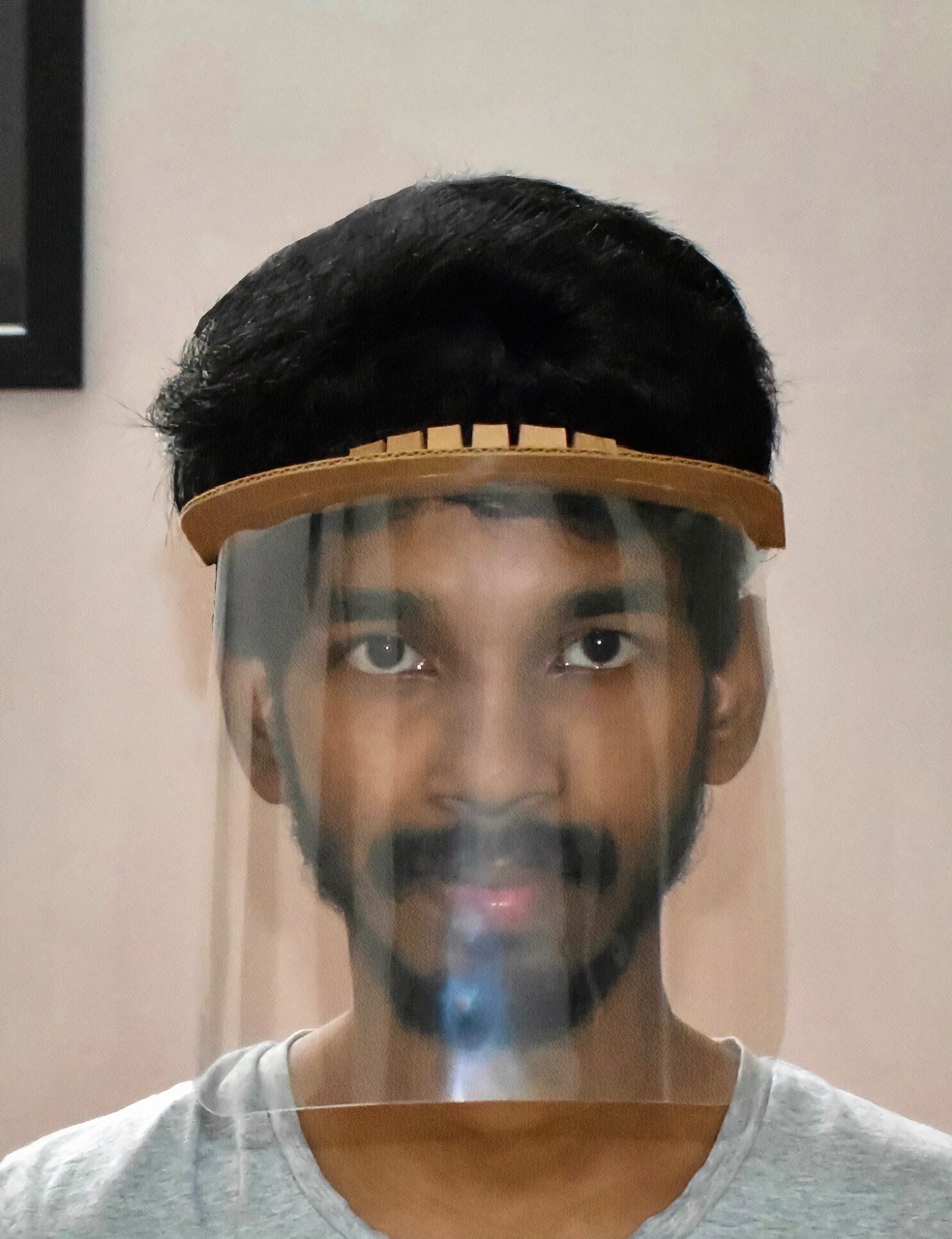 When the Covid-19 outbreak crippled the world, P Mohan Aditya, a 3rd-year Mechanical Engineering student from SRM University-AP, made an initiative of developing the highly useful face shield made from bio-degradable substances. He named it “Facial Shield 2.0”, as it was an improved version of the ordinary face shields. The innovative features added to it helped him to earn the copyright to his credit. On May 16, 2020, Aditya filed an application on the face shield design under the IPR (Intellectual Property Rights) with Indian Patent Office, located in Kolkata, India. In 2021, a copyright was granted for the” Face Shield for Humans” with a Design Application Number of 329364 – 001.
When the Covid-19 outbreak crippled the world, P Mohan Aditya, a 3rd-year Mechanical Engineering student from SRM University-AP, made an initiative of developing the highly useful face shield made from bio-degradable substances. He named it “Facial Shield 2.0”, as it was an improved version of the ordinary face shields. The innovative features added to it helped him to earn the copyright to his credit. On May 16, 2020, Aditya filed an application on the face shield design under the IPR (Intellectual Property Rights) with Indian Patent Office, located in Kolkata, India. In 2021, a copyright was granted for the” Face Shield for Humans” with a Design Application Number of 329364 – 001. The face shield 2.0 serves as the outer defence to the mucous membranes (nose, eyes, and mouth) and comes with a transparent visor made of a thin layer of 175-micron reusable plastic and a highly durable headband made of 3-ply corrugated cardboard. The cardboard’s bursting strength is 16kg/sq.cm, which is quite durable yet lightweight. Due to the use of biodegradable materials, the price of a face shield is at an affordable cost of INR 15. The face shield 2.0, made with firm elastic, is adjustable and suitable for all head sizes for comfortable wear without hurting the head.
Shri Adimulapu Suresh, Hon’ble Minister of Education, Andhra Pradesh and Sri Nandigama Suresh, Hon’ble MP, appreciated the student’s efforts in the Secretariat’s premises. Aditya received high accolades from the guests present on his first successful invention. They also distributed face shields among state police officers, paramedics and other frontline workers deployed in the containment areas.
In a conversation with P Mohan Aditya, he says, “With an increasing environmental degradation, we should move to the eco-friendly alternatives to develop products/services. Therefore, I thought to develop face shields from reusable plastic and cardboard, which are easily degradable. After discovering a shortage in the supply of Personal Protective Equipment (PPE) globally, the idea struck my mind. Immediately I started researching on developing a piece of standard equipment to combat the Covid-19 pandemic. I am thankful to Mr Ravi, the attorney at SRM-AP, who supported me throughout the tough times by answering all doubts amidst challenging circumstances.”
 Aditya’s invention turned out to be a successful project both for the University and the public. The leadership team of SRM University-AP – Dr P Sathyanarayanan, President, Prof V S Rao, Vice-Chancellor, and Prof D Narayana Rao, Pro-Vice-Chancellor expressed their happiness on Aditya’s success by congratulating him on developing the face shield and making use of eco-friendly technology.
Aditya’s invention turned out to be a successful project both for the University and the public. The leadership team of SRM University-AP – Dr P Sathyanarayanan, President, Prof V S Rao, Vice-Chancellor, and Prof D Narayana Rao, Pro-Vice-Chancellor expressed their happiness on Aditya’s success by congratulating him on developing the face shield and making use of eco-friendly technology.Using the CAD software, Aditya designed the transparent visor of the face shield and fabricated the remaining headband with the CNC machine. The CAD model was used as the input to the CNC machine, Following the design, the CNC machine analysed and cut the cardboard and transparent sheet accordingly.
P Mohan Aditya’s another innovative design on “building block for bed” was applied for a copyright on 09-08-2020. The building block for bed is again an innovative work of making beds using reusable materials for COVID 19 patients. He and his team also successfully created an electric bicycle using a 24V 250Watt DC motor powered by a 12V and 12Ah battery as a team assignment. Aditya desires to be a successful engineer and creator of such inventions for the betterment of society.
Continue reading → - SRM University-AP receives oxygen concentrators from collaborator TEC-NTHU May 27, 2021
Deccan Chronicle – May 27

The Hindu – May 27

The Hans India – May 27
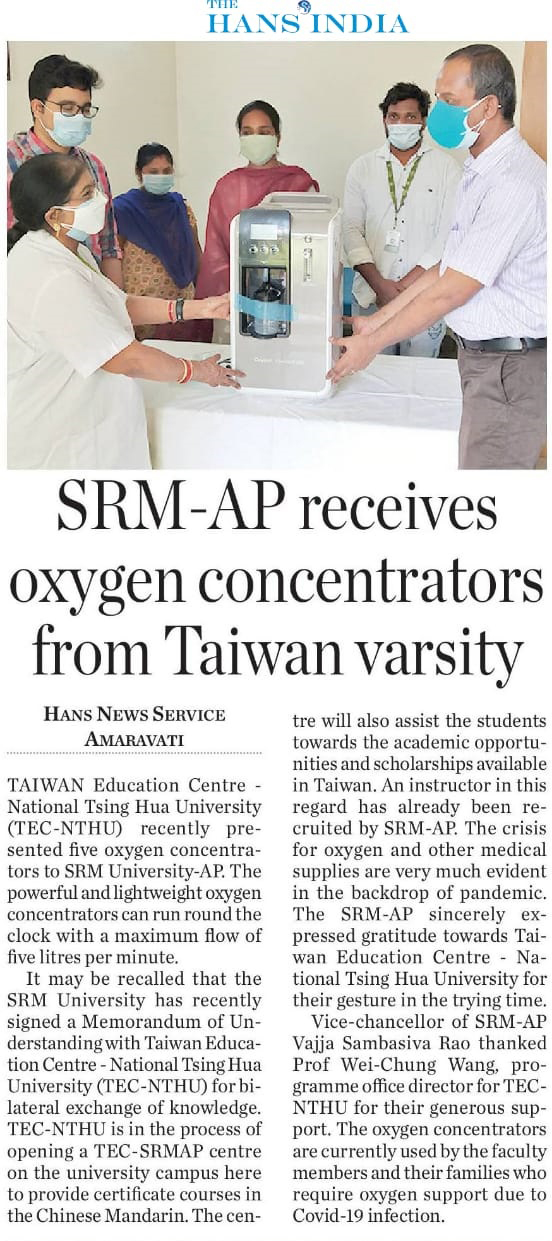
Business News This Week – May 26
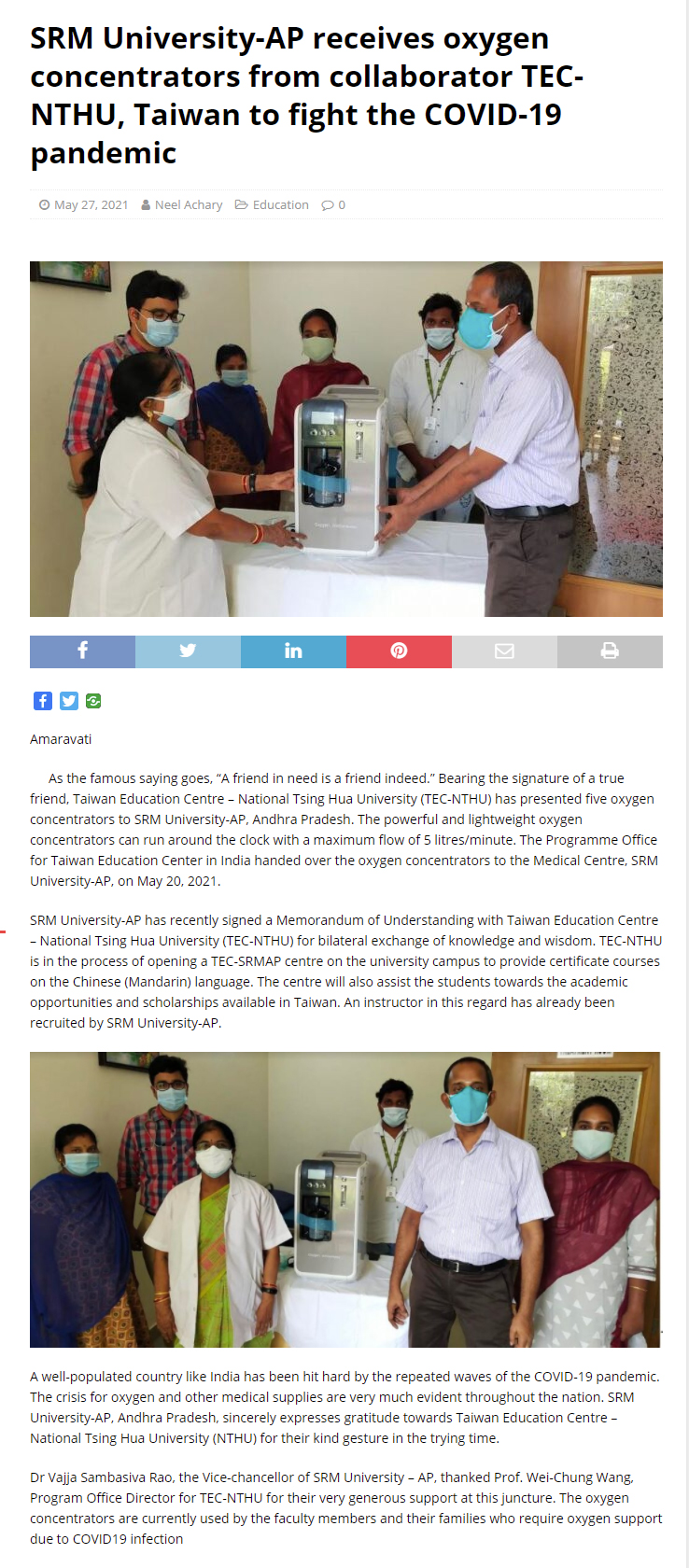
Higher Education Digest – May 26
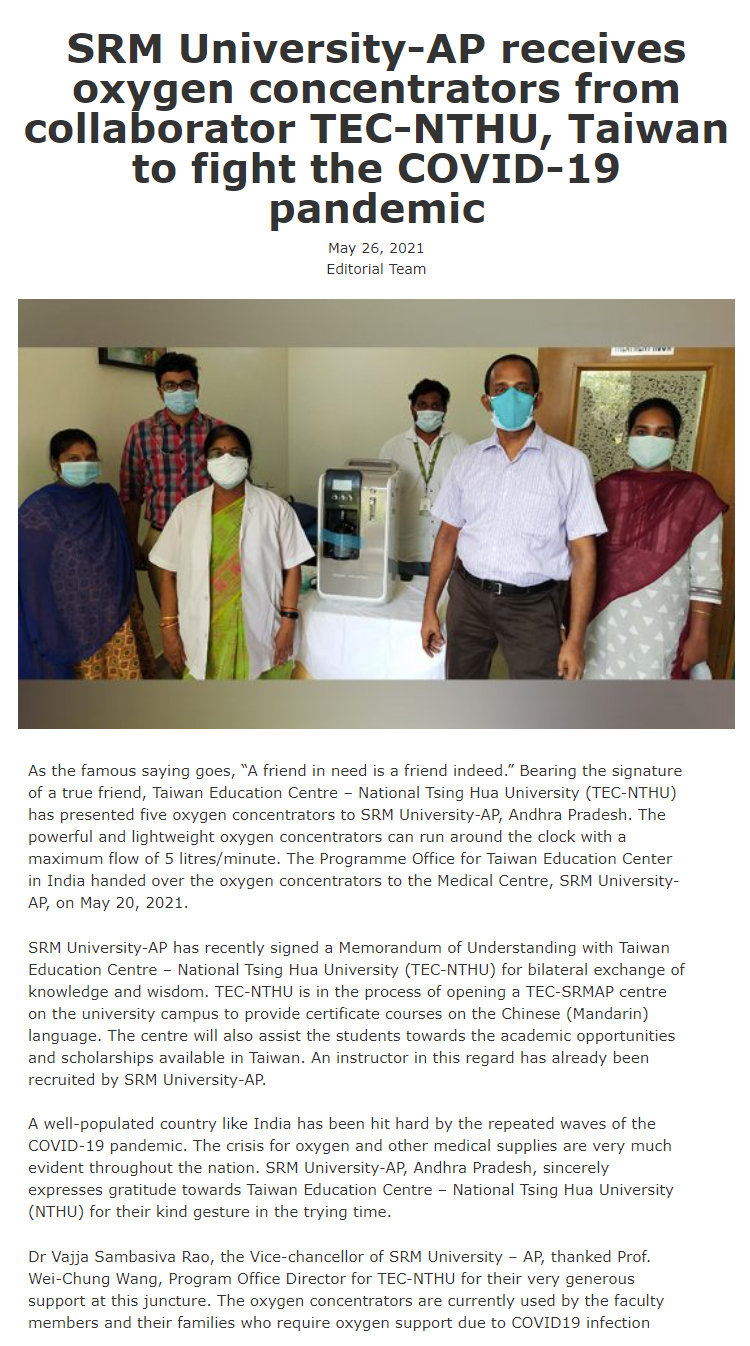
Content Media Solution – May 27
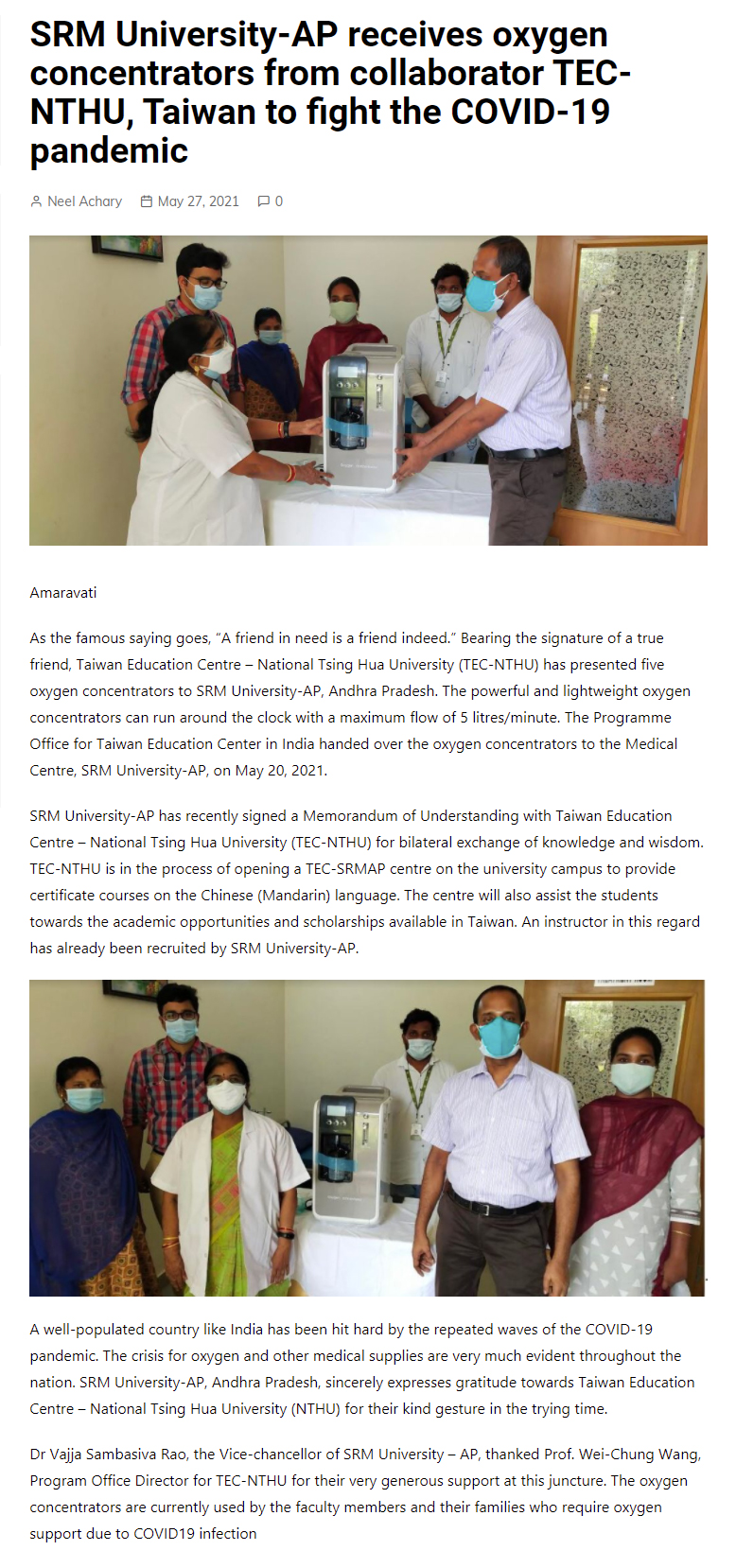
Praja Sakthi – May 27
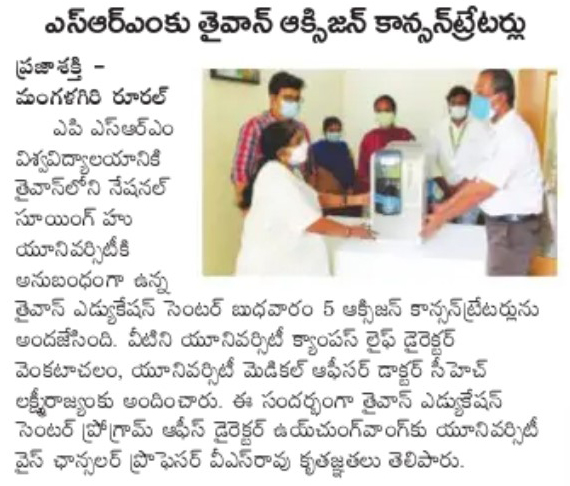
Surya Daily – May 27
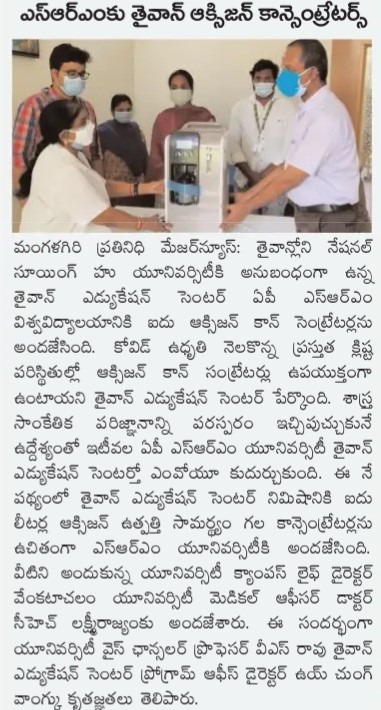
Vartha Prapancham – May 27
Continue reading →
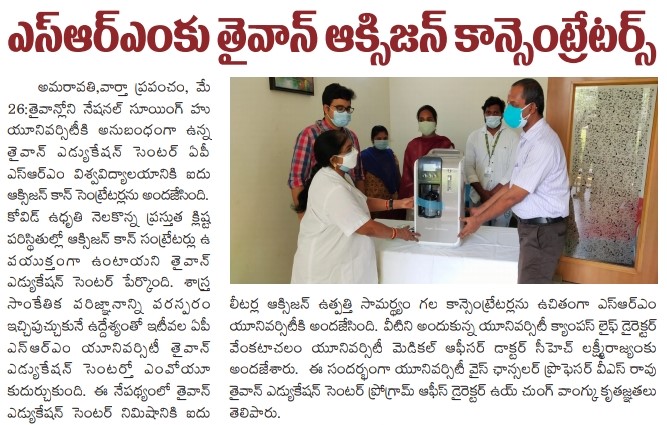
- SRM University-AP receives oxygen concentrators from collaborator TEC-NTHU to fight the COVID-19 pandemic May 26, 2021
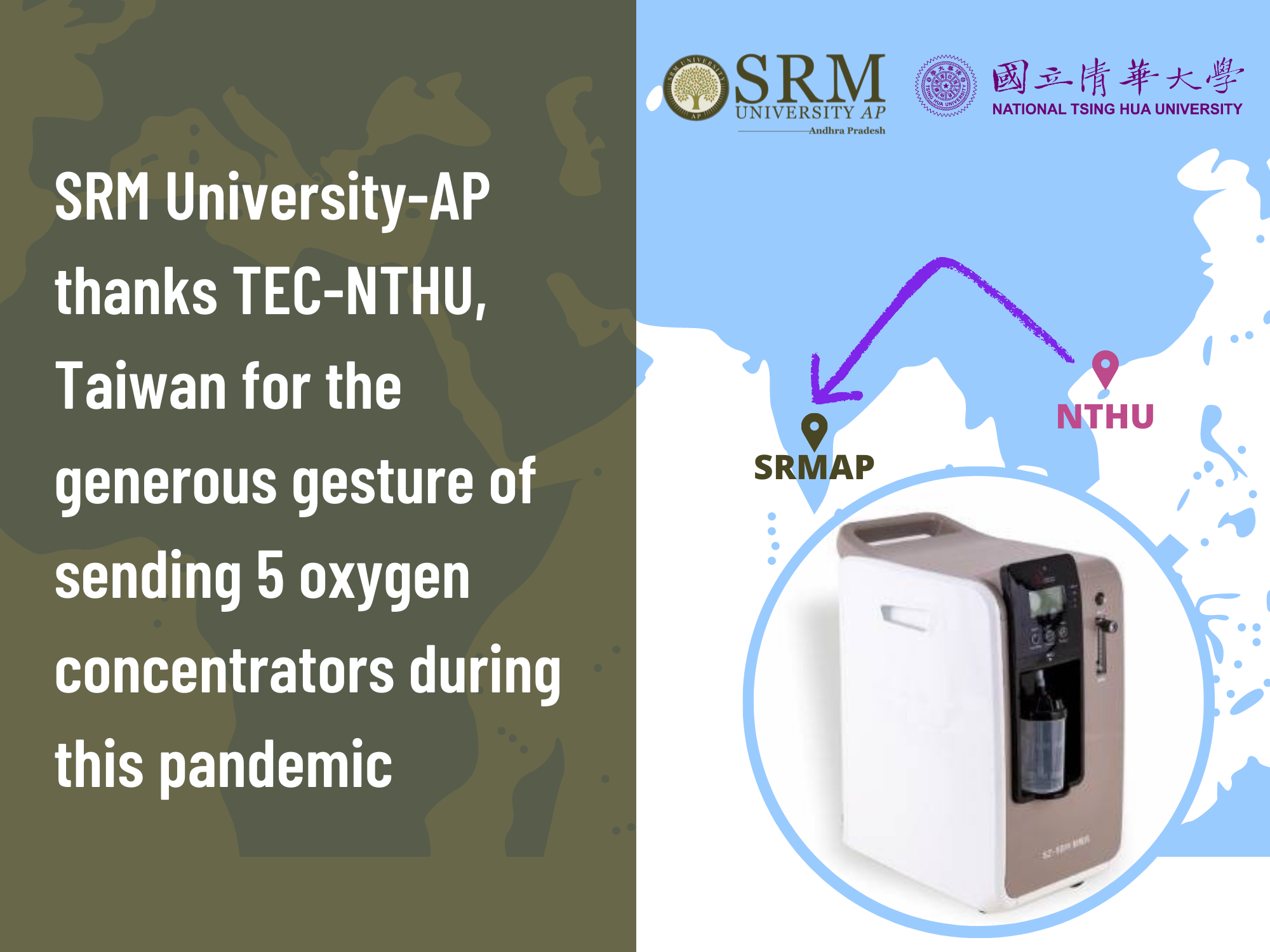 As the famous saying goes, “A friend in need is a friend indeed.” Bearing the signature of a true friend, Taiwan Education Centre – National Tsing Hua University (TEC-NTHU) has presented five oxygen concentrators to SRM University-AP, Andhra Pradesh. The powerful and lightweight oxygen concentrators can run around the clock with a maximum flow of 5 litres/minute. The Programme Office for Taiwan Education Center in India handed over the oxygen concentrators to the Medical Centre, SRM University-AP, on May 20, 2021.
As the famous saying goes, “A friend in need is a friend indeed.” Bearing the signature of a true friend, Taiwan Education Centre – National Tsing Hua University (TEC-NTHU) has presented five oxygen concentrators to SRM University-AP, Andhra Pradesh. The powerful and lightweight oxygen concentrators can run around the clock with a maximum flow of 5 litres/minute. The Programme Office for Taiwan Education Center in India handed over the oxygen concentrators to the Medical Centre, SRM University-AP, on May 20, 2021.SRM University-AP has recently signed a Memorandum of Understanding with Taiwan Education Centre – National Tsing Hua University (TEC-NTHU) for bilateral exchange of knowledge and wisdom. TEC-NTHU is in the process of opening a TEC-SRMAP centre on the university campus to provide certificate courses on the Chinese (Mandarin) language. The centre will also assist the students towards the academic opportunities and scholarships available in Taiwan. An instructor in this regard has already been recruited by SRM University-AP.
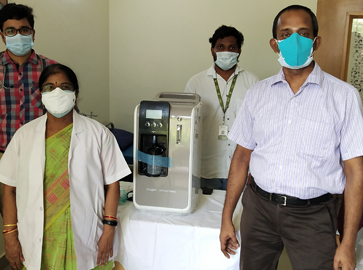 A well-populated country like India has been hit hard by the repeated waves of the COVID-19 pandemic. The crisis for oxygen and other medical supplies are very much evident throughout the nation. SRM University-AP, Andhra Pradesh, sincerely expresses gratitude towards Taiwan Education Centre – National Tsing Hua University (NTHU) for their kind gesture in the trying time.
A well-populated country like India has been hit hard by the repeated waves of the COVID-19 pandemic. The crisis for oxygen and other medical supplies are very much evident throughout the nation. SRM University-AP, Andhra Pradesh, sincerely expresses gratitude towards Taiwan Education Centre – National Tsing Hua University (NTHU) for their kind gesture in the trying time.Dr V S Rao, the Vice-chancellor of SRM University – AP, thanked Prof. Wei-Chung Wang, Program Office Director for TEC-NTHU for their very generous support at this juncture. The oxygen concentrators are currently used by the faculty members and their families who require oxygen support due to COVID19 infection.
Continue reading → - Dr Satya Pramod Jammy receives a grant to research missiles and space vehicles May 26, 2021
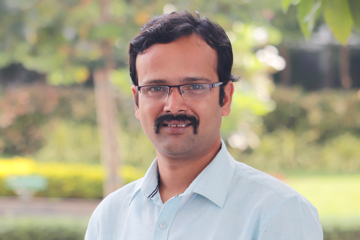 Dr Satya Pramod Jammy, Associate Professor, Department of Mechanical Engineering, SRM University-AP, Andhra Pradesh, has received a total outlay of Rs. 38,61, 264/- from Department of Science and Technology (DST) Science and Engineering Research Board, Government of India, to work on the project titled “Wall effects in Shock wave boundary layer interactions”. Using the grant, state-of-the-art HPC computational facilities based on the exciting General Purpose Graphic Processing Units (GPGPU’s) will be set up to perform missiles and space vehicle research at SRM University AP. Understanding the fundamental physics of how these vehicles behave in challenging atmospheres will contribute a lot to the design of current and future space vehicles re-entering from space into earth and mars atmospheres. The project aims to develop methods that can capture high-resolution images (like a DSLR camera) of these flows using minimal computational resources.
Dr Satya Pramod Jammy, Associate Professor, Department of Mechanical Engineering, SRM University-AP, Andhra Pradesh, has received a total outlay of Rs. 38,61, 264/- from Department of Science and Technology (DST) Science and Engineering Research Board, Government of India, to work on the project titled “Wall effects in Shock wave boundary layer interactions”. Using the grant, state-of-the-art HPC computational facilities based on the exciting General Purpose Graphic Processing Units (GPGPU’s) will be set up to perform missiles and space vehicle research at SRM University AP. Understanding the fundamental physics of how these vehicles behave in challenging atmospheres will contribute a lot to the design of current and future space vehicles re-entering from space into earth and mars atmospheres. The project aims to develop methods that can capture high-resolution images (like a DSLR camera) of these flows using minimal computational resources.Dr Jammy is an expert in multi-scale modelling of turbulent flows at high Mach numbers. He is also the lead developer of OpenSBLI, a free and open-source software (FOSS) distributed to the community for free. Dr Jammy and his group will focus on unravelling the concepts like engine unstart in SCRAMJETS, design of better aerodynamic control surfaces for re-entry.
Continue reading → - Novel designs for electrochemical ammonia synthesis to substitute Haber-Bosch process May 26, 2021
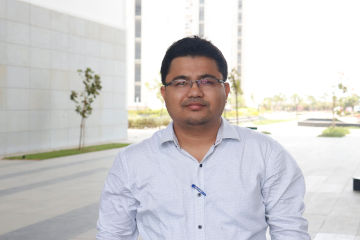 Professor Ranjit Thapa, Head of the Department of Physics, has recently published a paper “Unveiling the Genesis of the High Catalytic Activity in Nickel Phthalocyanine for Electrochemical Ammonia Synthesis” in the renowned Journal of Materials Chemistry A, Royal Society of Chemistry (Impact Factor: 11.301). The work has been done in collaboration with the Department of Industrial Chemistry & Applied Chemistry, Swami Vivekananda Research Centre, Ramakrishna Mission Vidyamandira, Belur Math, Howrah; Rubber Technology Centre, Indian Institute of Technology, Kharagpur; and Atomic & Molecular Physics Division, Bhabha Atomic Research Centre, Mumbai, India.
Professor Ranjit Thapa, Head of the Department of Physics, has recently published a paper “Unveiling the Genesis of the High Catalytic Activity in Nickel Phthalocyanine for Electrochemical Ammonia Synthesis” in the renowned Journal of Materials Chemistry A, Royal Society of Chemistry (Impact Factor: 11.301). The work has been done in collaboration with the Department of Industrial Chemistry & Applied Chemistry, Swami Vivekananda Research Centre, Ramakrishna Mission Vidyamandira, Belur Math, Howrah; Rubber Technology Centre, Indian Institute of Technology, Kharagpur; and Atomic & Molecular Physics Division, Bhabha Atomic Research Centre, Mumbai, India.The slow kinetics of N2 adsorption, splitting of the strong N≡N bond are the challenges for the electrocatalytic nitrogen reduction reaction (NRR) process. In the electrocatalytic NRR process, the fast reaction kinetics of hydrogen evolution reaction is the greatest obstacle. To solve these challenges, the search for various types of catalysts is on a roll. Also, identifying active sites responsible for the origin of catalytic activity in transition metal phthalocyanine is difficult due to its complex structure. Herein, density functional theory (DFT) has been applied to identify the probable active sites of nickel phthalocyanine (NiPc) in NRR as well as the origin of catalytic activity, which is associated with d band centre and density of states (DOS) of Ni in NiPc. Accordingly, the NiPc nanorods (NRs) were synthesised by the solvothermal method on a large scale and the chemically prepared NiPc NRs exhibit the NH3 yield rate of about 85 μg h-1mgcat-1.
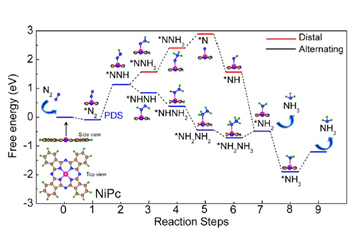 In 2019, the global production capacity of ammonia was 235 million metric tons which will increase to 290 million metric tons by 2030. This emphasis on ammonia is due to its application in broad and diverse fields, such as fertilisers, textiles, pharmaceutical, and carbon-free energy carriers. The Haber-Bosch process is used to synthesise ammonia (NH3) from N2 and H2 using Fe based catalyst. However, the process emits carbon dioxide (CO2) (1.5 tons of CO2/tons of NH3 production) and requires high pressure and temperature and consumes around 2% of the global energy supply. Electrocatalytic N2 fixation (N2 + 6H+ + 6e− → 2NH3) showed great potential due to the possible use of atmospheric nitrogen and hydrogen derived from water through electrolysis and in mild conditions.
In 2019, the global production capacity of ammonia was 235 million metric tons which will increase to 290 million metric tons by 2030. This emphasis on ammonia is due to its application in broad and diverse fields, such as fertilisers, textiles, pharmaceutical, and carbon-free energy carriers. The Haber-Bosch process is used to synthesise ammonia (NH3) from N2 and H2 using Fe based catalyst. However, the process emits carbon dioxide (CO2) (1.5 tons of CO2/tons of NH3 production) and requires high pressure and temperature and consumes around 2% of the global energy supply. Electrocatalytic N2 fixation (N2 + 6H+ + 6e− → 2NH3) showed great potential due to the possible use of atmospheric nitrogen and hydrogen derived from water through electrolysis and in mild conditions.In their future endeavours, Prof Thapa and his research group will design different types of such single-atom catalyst (SAC) considering different metal atoms and their surrounding non-metals. Dr Thapa’s team necessitates addressing the above problem to fill the gap, which could be the energy equation, energy parameter and electronic descriptor, to help them predict the best SAC catalyst in the large catalyst space for eNRR over HER. The solution is much needed through density functional theory to understand the origin and design principle and lower the time for trials by experimentalists in the laboratory. Prof Thapa is working on energy equations that can predict the best catalyst for eNRR over HER. They defined four regions to find the SAC catalyst for eNRR over HER (1) catalyst for NRR with almost nil HER probability (ii) catalyst for NRR with low HER probability (iii) HER over NRR and (iv) NRR is possible but with H poisoning. Overall, the energy parameter and descriptor to find NRR over HER is a fundamental problem, and the database is a platform to be used by experimentalists and is the key idea.
Read the full paper: https://doi.org/10.1039/D1TA00766A.
Continue reading → - Intriguing discussion on “Dietary Risk Factors for Non-Communicable Diseases (NCDs) and Dietary Management” May 24, 2021
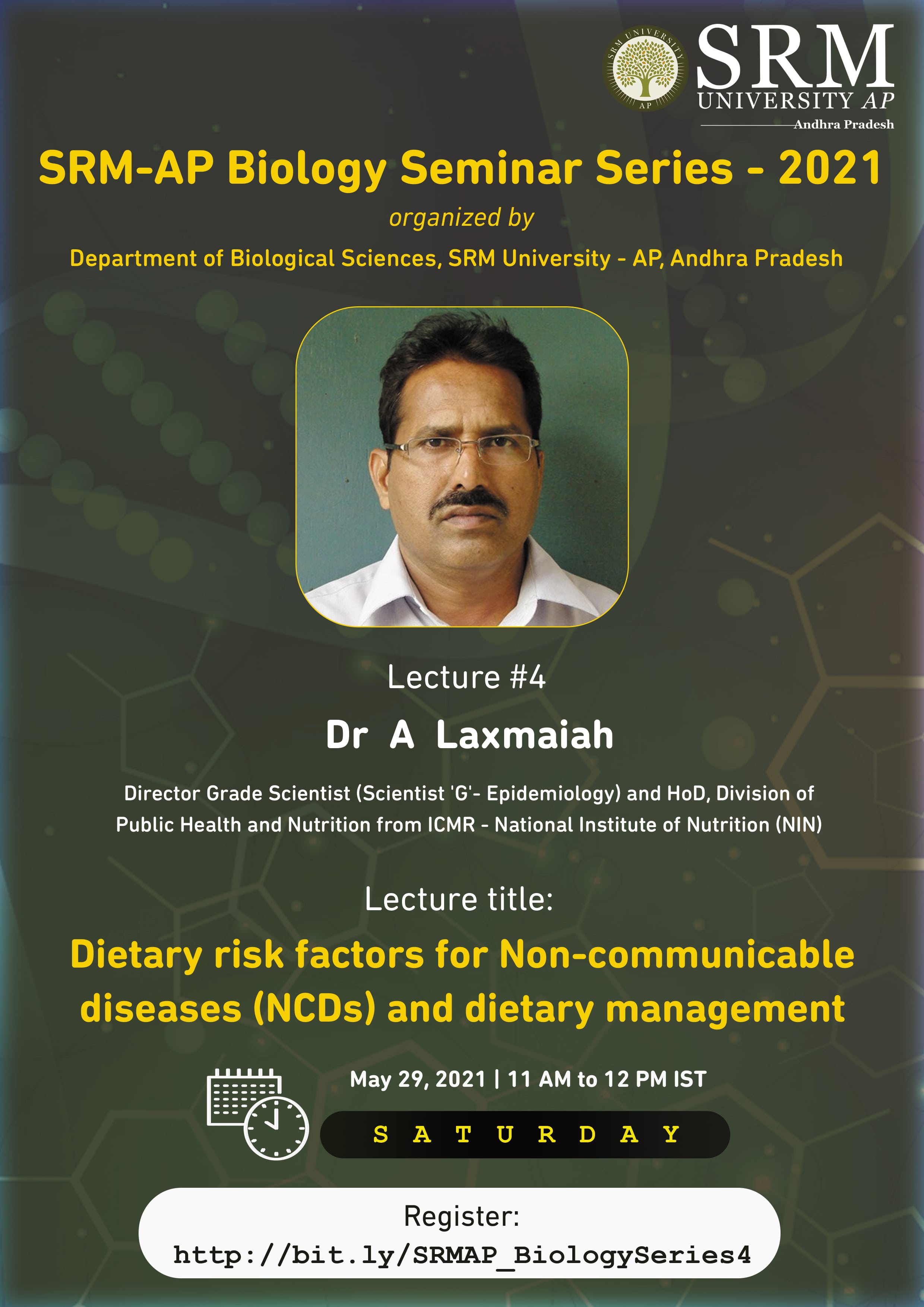 The fourth edition of the Biology Seminar Series presents an enthralling webinar on “Dietary Risk Factors for Non-Communicable Diseases (NCDs) and Dietary Management.” Dr A Laxmaiah, Director Grade Scientist (Scientist ‘G’- Epidemiology) and HoD, Division of Public Health and Nutrition from ICMR – National Institute of Nutrition (NIN), will grace the event as the keynote speaker. The webinar has been scheduled for May 29, 2021, at 11 am.
The fourth edition of the Biology Seminar Series presents an enthralling webinar on “Dietary Risk Factors for Non-Communicable Diseases (NCDs) and Dietary Management.” Dr A Laxmaiah, Director Grade Scientist (Scientist ‘G’- Epidemiology) and HoD, Division of Public Health and Nutrition from ICMR – National Institute of Nutrition (NIN), will grace the event as the keynote speaker. The webinar has been scheduled for May 29, 2021, at 11 am.Dr A Laxmaiah has an academic background in Medicine and Public Health, with hands-on professional experience in Public Health Nutrition at the National Institute of Nutrition (NIN), ICMR, Hyderabad. He is involved in many training & capacity building programmes in health and nutrition care. He has carried out several epidemiological, operational research and randomized clinical trials (RCT) in the field of Health and Nutrition. Dr A Laxmaiah further attended and presented numerous research papers in National and International Conferences, Seminars, workshops and meetings.
Dr A Laxmaiah has published more than 120 papers in National & International journals like The Lancet and BMJ. He is a subject Expert member in several health and nutrition committees of various Ministries like Department of Women and Child Development (MoWCD), Health & Family Welfare (MoHFW), National Disaster Management Authority (NDMA), Science and Technology (DST), HRD (MDM Programme), Government of India and in many National and International NGOs.
Dr A Laxmaiah graduated in medicine (MBBS) from Kakatiya Medical College, Warangal in 1987. After that, he obtained a Post Graduate Diploma in Public Health (DPH), Osmania Medical College, Hyderabad in 1992 and a Post Graduate Certificate in Applied Nutrition from National Institute of Nutrition, Hyderabad in 1994. Dr A Laxmaiah pursued Master Degree in Public Health (MPH) from Sree Chitra Tirunal Institute of Medicine Sciences and Technology, Thiruvanathapuram, Kerala and a Master in Business Management (MBA). Lastly, he was awarded a PhD in Public Health Nutrition by the NTR University of Health Sciences, Vijayawada in 2014. He has written many book chapters on health and Nutrition and received several national and international training in health and Nutrition.
Dr A Laxmaiah has been honoured with many awards and accolades. He has received the International training Fellowship Award in the year 2006 from the ‘International Union of Nutritional Sciences (IUNS), USA, to attend the African Nutrition Epidemiology Conference in August 2006, Ghana, South Africa. He was awarded INF/Kraft Fellowship for the training of “Institutional Research Capacity Strengthening in Nutrition” in September 2007 and also attended the 10th Asian Congress of Nutrition at Taipei, Taiwan. Dr A Laxmaiah received the Best Paper Award in the year 2008 for the paper “Pattern of indigenous vegetables and legumes consumption in rural India”, presented in the International Conference on Indigenous Vegetables and Legumes. Prospectus for Fighting Poverty, Hunger and Malnutrition, ICRISAT, Patancheru, Hyderabad. He was selected for the ‘International Health Professional of the year 2010’, awarded by the Research and Advisory Board, International Biographical Centre, Cambridge, UK. Dr A Laxmaiah also received a Postdoctoral Training Award from the Bristol University and London School of Hygiene and Public Health, UK., in 2012. He was further selected as an ‘Honorary Senior Research Fellow’ in the Faculty of Medicine at the Royal Imperial College, London, UK, in recognition of his contributions to the field of Nutrition and Health.
Join the webinar on May 29, 2021, at 11 am to avail yourself the opportunity to learn more on Dietary risk factors for Non-communicable diseases from the expert himself.
Register:http://bit.ly/SRMAP_BiologySeries4
Continue reading → - Hsin-Yi, Huang May 22, 2021
- SRM University-AP & Titan Company Ltd collaborate to engineer novel gold alloys for contemporary jewellery May 20, 2021
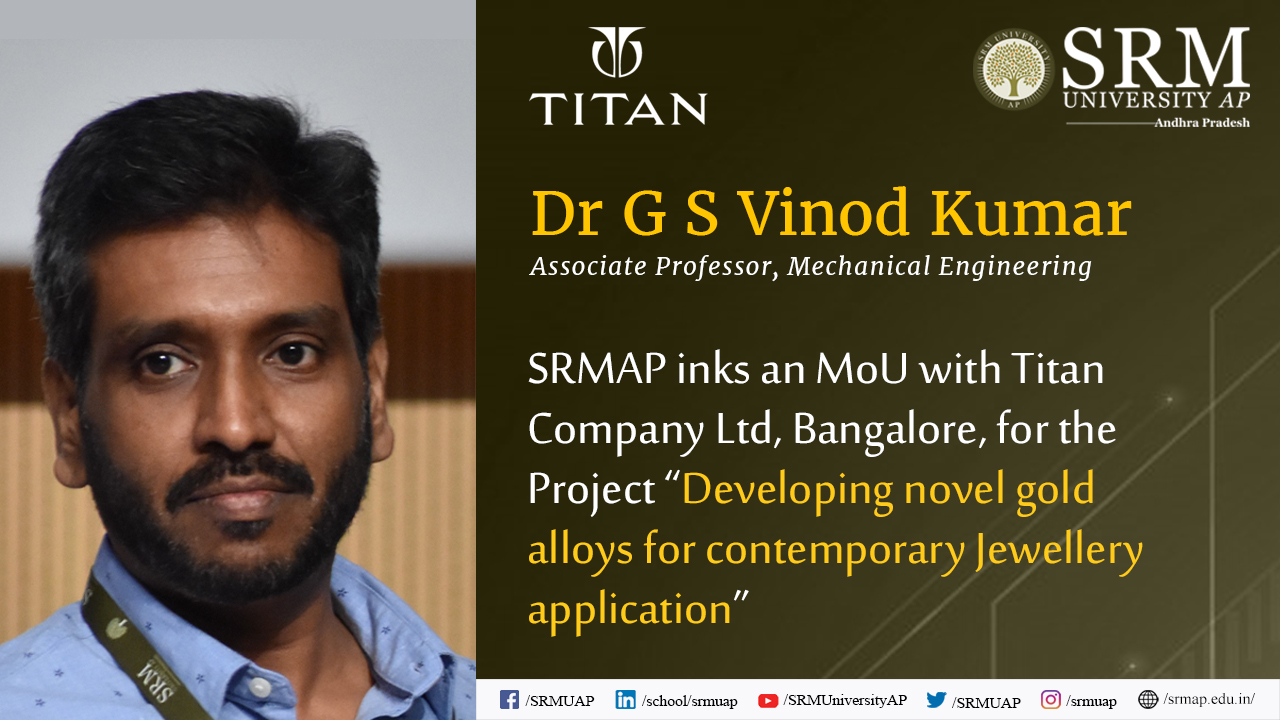 SRM University-AP inked an MOU with Titan Company Ltd (TATA group,) Bangalore, for the project “Developing novel gold alloys for contemporary Jewellery application”. Titan has sanctioned Rs. 29.6 lakhs for the execution of the project to Dr G S Vinod Kumar, Associate Professor in the Department of Mechanical Engineering and Principal Investigator of the project. Dr Vinod is well known for his research in precious metals such as gold and silver for making lightweight and high strength alloys that can be used in jewellery making.
SRM University-AP inked an MOU with Titan Company Ltd (TATA group,) Bangalore, for the project “Developing novel gold alloys for contemporary Jewellery application”. Titan has sanctioned Rs. 29.6 lakhs for the execution of the project to Dr G S Vinod Kumar, Associate Professor in the Department of Mechanical Engineering and Principal Investigator of the project. Dr Vinod is well known for his research in precious metals such as gold and silver for making lightweight and high strength alloys that can be used in jewellery making.The jewellery division of Titan Company Ltd (TANISHQ) will jointly work on this project by supplying Gold for lab-scale experiments. The Industrial scaling up trials of the technology will be carried out at Titan’s jewellery manufacturing plant at Hosur, Tamil Nadu.
This is the fourth project sanctioned by Titan Company Ltd to Dr G S Vinod Kumar and the second project in Gold. The first project “Hardening of 22Karat and 24Karat gold for lightweight and high strength jewellery application” was successfully completed in 2018 by Dr Vinod and his team. A joint patent between SRM and Titan Company Ltd has been filed and the jewellery produced from hard 22Karat gold is currently available in Titan showrooms under the brand-TANISHQ.
Continue reading →


